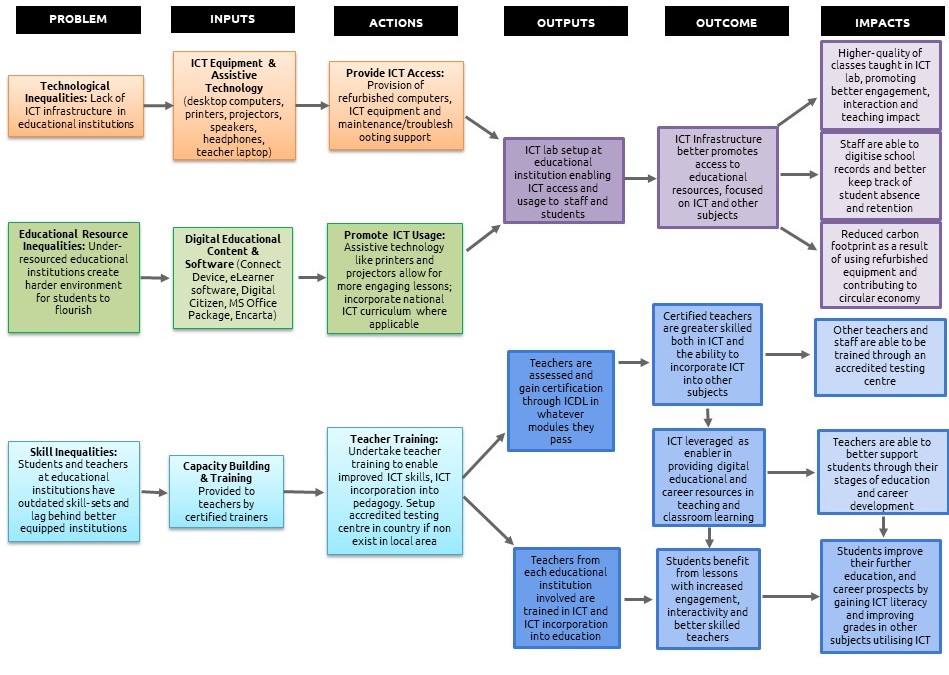Computer Aid International works to reduce technological inequalities, particularly in the developing world. As part of refining our work and improving the effectiveness and outcomes of projects, we have intensified our work in a number of countries in Africa that allow technological projects to better-thrive given government policies, electrical access and a range of other environmental factors.
Whilst focusing our work to where it can be most effective, we have been refining our training and monitoring processes; arguably two of the most important components to an educational technology-for-development project. We now work to ensure that training taking place during the project’s life, will not only have benefits in the life of the project, but also once the project concludes and well into the future. This sustainability is created through our training process with the ICDL Foundation.
During the project’s life, our local technology partner will become ICDL accredited, meaning that a number of their staff have been trained and passed assessment in various modules focused on computer use. These modules include ‘Computer Essentials’, ‘Word Processing’, ‘Online Essentials’, and ‘Spreadsheets.’
We have three main types of beneficiary in our educational projects; Group 1 is staff from our chosen technology partner who often have relatively better skills, but still require development; Group 2 is made up of teachers from each of the schools we work with for a given project; Group 3 consists of students who will be benefitting from the computer lab we install at each of the schools in our project.
The project training follows the following process:
- Technology Partners (Group 1) are trained directly by ICDL and pass ICDL assessment; They then undertake ‘Training of the Trainers’ where they are taught how to train others.
- Teachers (Group 2) from all schools in a project are trained by Technology Partners in ICDL modules and take ICDL assessments once training has been completed. Teachers gain ICDL certification in each of the modules that they pass.
- Students (Group 3) at each of the schools involved in the project have classes with trained Teachers both dedicated to ICT and STEM subjects.
This process dramatically expands ICT literacy in areas where a project is run and continues to increase ICT literacy thereafter, since our partners can continually offer ICDL training, assessment and certification to any individuals interested through their accredited test centre.
Our monitoring process utilises quantitative and qualitative data to gain an understanding of project outcomes. Our primary focus is to obtain factual quantitative data that undisputedly proves an outcome or change. For example, the data obtained from ICDL assessments is an accurate indicator of an individuals ICT literacy. If they have passed all modules, we can be fairly certain that they are indeed ICT literate. We attempt to minimise the use of data that is self-reported or relies on subjectivity, since this is prone to be unreliable, though we are still interested in opinions and having feedback from beneficiaries.
Our Theory of Change is shown below:

Our monitoring framework largely follows that of the International Telecommunications Union (ITU), in that we focus on three broad areas to monitor across a project lifetime. These include Access, Usage and Skills.
Access: This relates to how many new individuals are accessing computers at the schools we have installed computer labs in, in a given project.
Usage: This relates to how the computers are being used, particularly in classes, for example, what software are students using, which subjects are students being taught using computers and what digital educational content are they utilising.
Skills: This relates largely to the skills gained by both teachers and students and is closely linked to ICDL assessment. We also monitor the impact ICT has on students’ grades for other subjects which are taught in the computer lab.
Through these 3 key areas, we are able to effectively monitor the impact of the project’s various dimensions.
We also collect school aggregate metrics at the start and end of the project to see what broader impact the project has had on key school variables such as Student Attendance, Absence Rate, Student Retention and STEM Grades. We also monitor the impact on Teacher Attendance, Absence and Retention.
In summary, we focus on where our projects can have the greatest impact. Both training and monitoring play a key role in our projects and we have worked to improve both those components, whilst ensuring that beneficiaries of our project will improve their skill-set, job prospects and this will hopefully lead to a more prosperous future.
